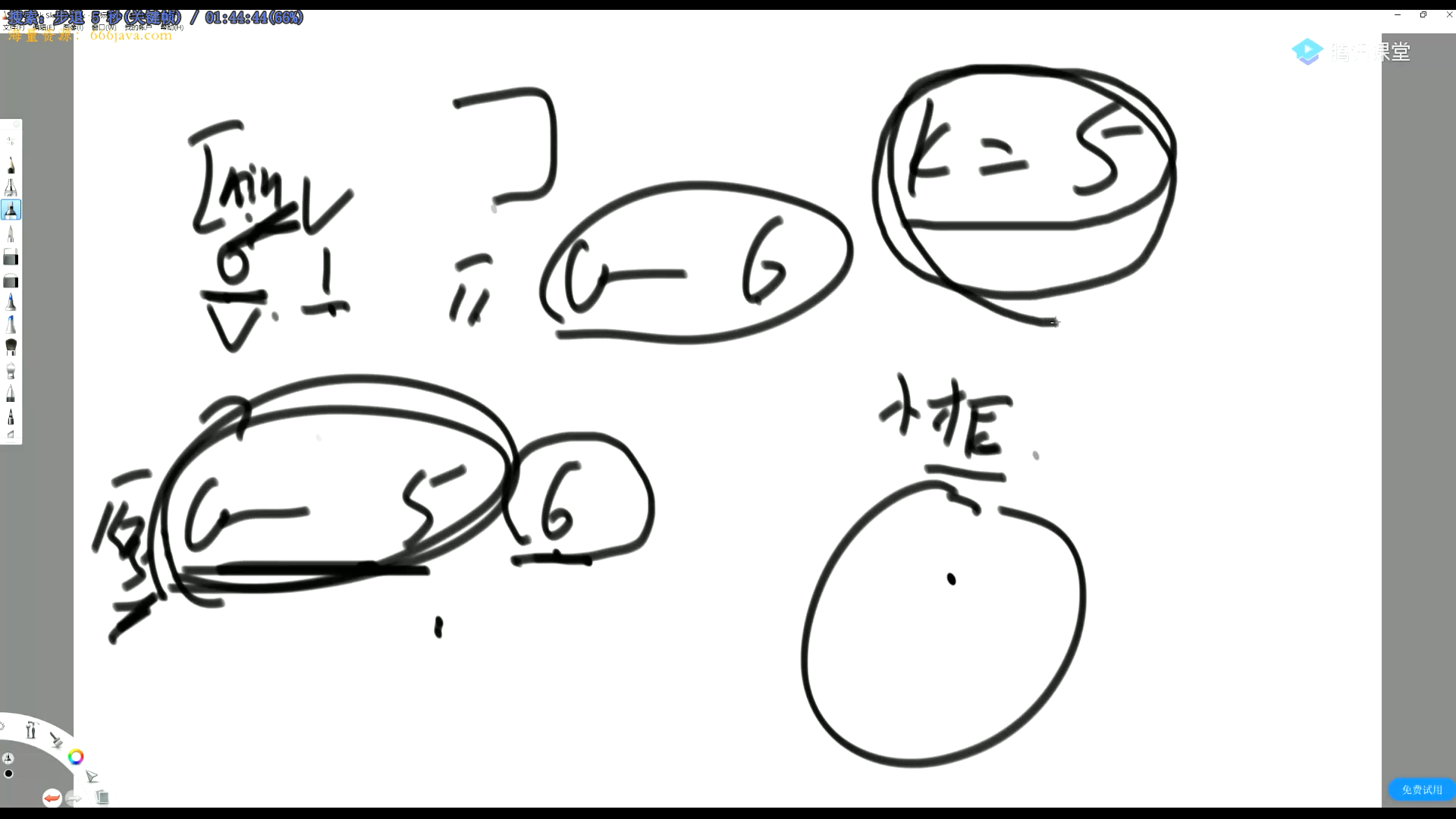比较器与堆
堆
满二叉树、完全二叉树、平衡二叉树、最优二叉树的基本概念和区别
- 堆结构就是用数组实现的完全二叉树结构
- 完全二叉树中如果每棵子树的最大值都在顶部就是大根堆
- 完全二叉树中如果每棵子树的最小值都在顶部就是小根堆
- 堆结构的heapInsert与heapify操作
- 堆结构的增大和减少
- 优先级队列结构,就是堆结构
- 用数组来保存完全二叉树,如果从0下标开始存,那么推断:
- 这个节点的左孩子为:2*i+1
- 这个节点的右孩子为:2*i+2
- 这个节点的父亲为:(i-1)/2
- 但是有的会把数组的0位置弃而不用(因为计算左孩子比较多的情况,可以直接利用位运算,这样速度最快),这个公式是什么样子呢?
- 这个节点的左孩子为:2*i(i<<1)
- 这个节点的右孩子为:2*i+1(i<<1 | 1)
- 这个节点的父亲为:i/2(i>>1)
- 有N个数,想象的树,的高度,是logN级别的
- 收到一个数字,调整到合适的未知,只需要探父节点,也就是logN的代价
public static class MyMaxHeap {
private int[] heap;
private final int limit;
private int heapSize;
public MyMaxHeap(int limit) {
heap = new int[limit];
this.limit = limit;
heapSize = 0;
}
public boolean isEmpty() {
return heapSize == 0;
}
public boolean isFull() {
return heapSize == limit;
}
public void push(int value) {
if (heapSize == limit) {
throw new RuntimeException("heap is full");
}
heap[heapSize] = value;
// value heapSize
heapInsert(heap, heapSize++);
}
// 用户此时,让你返回最大值,并且在大根堆中,把最大值删掉
// 剩下的数,依然保持大根堆组织
public int pop() {
int ans = heap[0];
swap(heap, 0, --heapSize);
heapify(heap, 0, heapSize);
return ans;
}
// 新加进来的数,现在停在了index位置,请依次往上移动,
// 移动到0位置,或者干不掉自己的父亲了,停!
private void heapInsert(int[] arr, int index) {
// [index] [index-1]/2
// index == 0
while (arr[index] > arr[(index - 1) / 2]) {
swap(arr, index, (index - 1) / 2);
index = (index - 1) / 2;
}
}
// 从index位置,往下看,不断的下沉
// 停:较大的孩子都不再比index位置的数大;已经没孩子了
// heapSize 想象中的最大值
private void heapify(int[] arr, int index, int heapSize) {
int left = index * 2 + 1;
while (left < heapSize) {
// 如果有左孩子,有没有右孩子,可能有可能没有!
// 把较大孩子的下标,给largest
// 右孩子胜出条件:1有右孩子,2右孩子的值比左孩子大;否则就是左孩子胜出
int largest = left + 1 < heapSize && arr[left + 1] > arr[left] ? left + 1 : left;
// 找到较大孩子的值,如果比父亲要大,largest不变,否则,如果没有pk过父亲,那父亲节点给largest
// 谁大谁把节点给largest
largest = arr[largest] > arr[index] ? largest : index;
if (largest == index) {
break;
}
// index和较大孩子,要互换
swap(arr, largest, index);
index = largest;
left = index * 2 + 1;
}
}
private void swap(int[] arr, int i, int j) {
int tmp = arr[i];
arr[i] = arr[j];
arr[j] = tmp;
}
}
堆排序
- 先让整个数组都变成大根堆结构,
- 建立堆的过程:
- 从上到下的方法,时间复杂度为O(N*logN);
- 从下到上的方法,时间复杂度为O(N);
- 把堆的最大值和堆末尾的值交换,然后减少堆的大小之后,再去调整堆,一直周而复始,时间复杂度为O(N*logN);
- 堆的大小减小成0之后,排序完成。
// 堆排序额外空间复杂度O(1)
public static void heapSort(int[] arr) {
if (arr == null || arr.length < 2) {
return;
}
// 从前往后
// O(N*logN)
// for (int i = 0; i < arr.length; i++) { // O(N)
// heapInsert(arr, i); // O(logN)
// }
// 从后往前走
// O(N)
for (int i = arr.length - 1; i >= 0; i--) {
heapify(arr, i, arr.length);
}
int heapSize = arr.length;
swap(arr, 0, --heapSize);
// O(N*logN)
while (heapSize > 0) { // O(N)
heapify(arr, 0, heapSize); // O(logN)
swap(arr, 0, --heapSize); // O(1)
}
}
// arr[index]刚来的数,往上
public static void heapInsert(int[] arr, int index) {
// arr[index]
// arr[index]不比 arr[index父]大了,停
// index = 0;
while (arr[index] > arr[(index - 1) / 2]) {
swap(arr, index, (index - 1) / 2);
index = (index - 1) / 2;
}
}
// arr[index]位置的数,能否往下移动
public static void heapify(int[] arr, int index, int heapSize) {
int left = index * 2 + 1; // 左孩子的下标
while (left < heapSize) { // 下方还有孩子的时候
// 两个孩子中,谁的值大,把下标给largest
// 1)只有左孩子,left -> largest
// 2) 同时有左孩子和右孩子,右孩子的值<= 左孩子的值,left -> largest
// 3) 同时有左孩子和右孩子并且右孩子的值> 左孩子的值, right -> largest
int largest = left + 1 < heapSize && arr[left + 1] > arr[left] ? left + 1 : left;
// 父和较大的孩子之间,谁的值大,把下标给largest
largest = arr[largest] > arr[index] ? largest : index;
if (largest == index) {
break;
}
swap(arr, largest, index);
index = largest;
left = index * 2 + 1;
}
}
public static void swap(int[] arr, int i, int j) {
int tmp = arr[i];
arr[i] = arr[j];
arr[j] = tmp;
}
语言提供的堆结构VS手写的堆结构
(优先级队列PriorityQueue,底层就是堆,默认为小根堆)
为什么还要手写堆结构?
- 取决于你有没有动态修改信息的需求。
- 对于语言自身的堆结构而言,你如果动态改数据,不保证依然有序;
- 对于手写堆结构,因为增加了对象的位置表,所以能够满足动态改信息的需求。
系统版本的堆结构
与堆有关的题目:已知一个几乎有序的数组,(几乎有序是指,如果把数组排好顺序的话,每个元素移动的距离一定不超过k,并且k相对于数组长度来说是比较小的。)请选择一个合适的排序策略,对这个数组进行排序。时间复杂度为O(N*logK)
- 小根堆
- 把0~0+k个数放到小根堆,第0个位置的数可以确定
- 把1~1+k个数放到小根堆,第1个位置的数可以确定
- …
- 排序完成

如果上过堆的东西,需要改动某些东西,自己手动写
/*
* T一定要是非基础类型,有基础类型需求包一层
*/
public class HeapGreater<T> {
private ArrayList<T> heap;
private HashMap<T, Integer> indexMap;
private int heapSize;
private Comparator<? super T> comparator;
public HeapGreater(Comparator<? super T> com) {
heap = new ArrayList<>();
indexMap = new HashMap<>();
heapSize = 0;
comparator = com;
}
public boolean isEmpty() {
return heapSize == 0;
}
public int size() {
return heapSize;
}
public boolean contains(T obj) {
return indexMap.containsKey(obj);
}
public T peek() {
return heap.get(0);
}
public void push(T obj) {
heap.add(obj);
indexMap.put(obj, heapSize);
heapInsert(heapSize++);
}
public T pop() {
T ans = heap.get(0);
swap(0, heapSize - 1);
indexMap.remove(ans);
heap.remove(--heapSize);
heapify(0);
return ans;
}
public void remove(T obj) {
T replace = heap.get(heapSize - 1);
int index = indexMap.get(obj);
indexMap.remove(obj);
heap.remove(--heapSize);
if (obj != replace) {
heap.set(index, replace);
indexMap.put(replace, index);
resign(replace);
}
}
public void resign(T obj) {
// 只会中一个,所以都写
heapInsert(indexMap.get(obj));
heapify(indexMap.get(obj));
// int valueIndex = indexMap.get(value);
// // 只会中一个,所以都写
// heapInsert(valueIndex);
// heapify(valueIndex, heapSize);
}
// 请返回堆上的所有元素
public List<T> getAllElements() {
List<T> ans = new ArrayList<>();
for (T c : heap) {
ans.add(c);
}
return ans;
}
private void heapInsert(int index) {
while (comparator.compare(heap.get(index), heap.get((index - 1) / 2)) < 0) {
swap(index, (index - 1) / 2);
index = (index - 1) / 2;
}
}
private void heapify(int index) {
int left = index * 2 + 1;
while (left < heapSize) {
int best = left + 1 < heapSize && comparator.compare(heap.get(left + 1), heap.get(left)) < 0 ? (left + 1) : left;
best = comparator.compare(heap.get(best), heap.get(index)) < 0 ? best : index;
if (best == index) {
break;
}
swap(best, index);
index = best;
left = index * 2 + 1;
}
}
private void swap(int i, int j) {
T o1 = heap.get(i);
T o2 = heap.get(j);
heap.set(i, o2);
heap.set(j, o1);
indexMap.put(o2, i);
indexMap.put(o1, j);
}
}
比较器
- 比较器的实质就是重载比较运算符;
- 比较器可以很好地应用在特殊标准的排序上;
- 比较器可以很好地应用在根据特殊标准排序的结构上;
- 写代码变得异常容易,还可以用于泛型编程。
- 案例:
compare(Student o1, Student o2)- 返回负数的时候,第一个参数排在前面
- 返回正数的时候,第二个参数排在前面
- 返回0的时候,谁在前面无所谓
All articles on this blog are licensed under CC BY-NC-SA 4.0 unless otherwise stated.